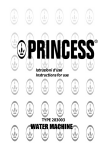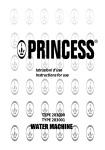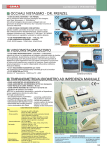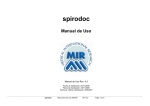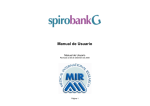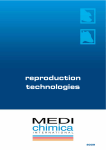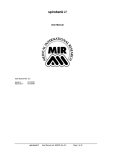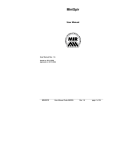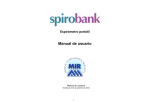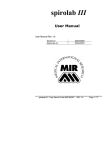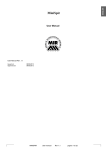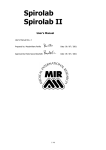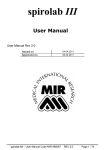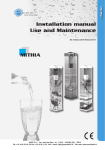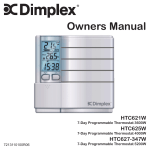Download SPYROMETER GIMASPIR-50
Transcript
SPYROMETER GIMASPIR-50 USE AND MAINTENANCE BOOK GIMA Spa - Via Monza, 102 - 20060 Gessate (MI) - Italia ITALIA: Tel. 199 400 401 (8 linee r.a.) - Fax 199 400 403 E-mail: [email protected] - www.gimaitaly.com INTERNATIONAL: Tel. ++39 02 953854209 - Fax ++39 02 95380056 E-mail: [email protected] - www.gimaitaly.com Gimaspir-50 - user's manual page 1 of 66 Thank you for choosing a GIMA product. The original packaging contains: • instrument Gimaspir-50 • 3 V DC lithium battery model CR 123A • Gimaspir-50 user’s manual Optional accessories: • oxymeter finger clip sensor • "wrap" finger sensor for oximetry over a long period Before using your Gimaspir-50… • Read the User’s Manual carefully and read all of the labels supplied with the unit. • Install the operating battery (if not already installed), taking care to connect correctly as shown inside the battery housing. • Select the required display language. Please keep the original packaging! In the event that your unit has a problem use the original packaging to return the unit to your distributor or to the manufacturer. GIMA has a policy of constant product improvement, and the technology within our products is also in constant evolution, thus we reserve the right to update these instructions as necessary. We appreciate all suggestions from our users. GIMA cannot be held responsible for any damage caused by users failing to follow the instructions and warnings within this manual. Note that due to printing limitations the screenshots shown in this manual may differ from the display of the machine and/or from the keyboard graphics. Copying this manual in whole or in part is forbidden. Gimaspir-50 - user's manual page 2 of 66 1. INTRODUCTION 1.1 Intended use 1.1.1 1.1.2 1.1.3 1.1.4 1.1.5 1.1.6 6 6 User category Qualification and experience required Operating environment Who must/can make the installation Patient effect on the use of the instrument Limitations of use – Contraindications 1.2 Important safety warnings 1.2.1 1.2.2 1.2.3 1.2.4 1.2.5 9 Danger of cross-contamination The turbine The mouthpiece The Pulse oxymetry sensor The instrument 10 10 11 11 13 1.3 Unforeseen errors 1.4 Labels and symbols 1.4.1 1.4.2 1.4.3 1.4.4 16 17 Identification Label CE mark for medical devices Electrical safety symbol Warning symbol for the RS232 serial port 1.5 Product description 1.6 Method of test interpretation 1.7 Technical specifications 1.7.1 1.7.2 1.7.3 17 17 18 18 19 21 22 Spirometer specifications Pulse oximeter specifications Other specifications 22 23 24 1.8 Spirometric normal values 26 2. OPERATION OF THE GIMASPIR-50 2.1 Keyboard 2.2 Battery level Gimaspir-50 - user's manual 6 6 6 7 7 7 27 27 29 page 3 of 66 2.3 To make a test 2.4 Entering subject data 2.4.1 30 34 New subject data 34 2.5 Making a spirometry test 2.6 Making a spot oxymetry test 2.7 Making long term oximetry testing 2.7.1 2.7.2 36 40 44 Instructions for use of the wrap sensor Making a test 3. TEST RESULTS 3.1 Interpretation of the spirometry test 3.2 Viewing the results 3.3 Print out of the results 3.3.1 44 46 48 48 49 51 Print out 52 4. MAINTENANCE 4.1 Cleaning and general control of the turbine 4.2 Replacement tape instructions 4.3 Changing the battery 53 53 55 56 5. POSSIBLE PROBLEMS 5.1 Causes and solutions 57 57 6. CONFIGURATION MANUAL FOR THE GIMASPIR-50 6.1 Configuration menu 58 59 6.1.1 6.1.2 6.1.3 6.1.4 6.1.5 6.1.6 6.1.7 6.1.8 Select Language Delete Test Data Oximetry: threshold values Oximetry: sampling rate Date Format Change Date/Time Predicted Values Unit Format Gimaspir-50 - user's manual 59 59 59 60 60 61 62 63 page 4 of 66 6.1.9 6.1.10 Select Printer Store All Test (for future developments) Declaration of EC Conformity Warranty Gimaspir-50 - user's manual page 5 of 66 63 64 1. INTRODUCTION 1.1 Intended use 1.1.1 User category The Gimaspir-50 spirometer + oxymeter measures a series of parameters relating to human respiratory function. The product is therefore intended for use by a doctor or by a paramedic under the supervision of a doctor. 1.1.2 Qualification and experience required The correct use of the instrument, the interpretation of the test results plus the maintenance of the instrument, in particular the sterilisation (to avoid the risk of cross-infection), all require qualified personnel. 1.1.3 Operating environment The operation of the instrument is foreseen within a doctor’s office or within a hospital ward. The instrument is not intended for use in an operating theatre or in the presence of inflammable liquids or detergents, nor in the presence of inflammable anaesthetic gases or oxygen or nitrogen gases. The instrument is not designed to be used in direct air currents (eg wind), sources of heat or cold, direct sun light or other sources or light or energy, dust, sand or any other chemical substances. The user is responsible to check the suitability of the ambiental conditions both for the storage and for the use of the instrument. If Gimaspir-50 is exposed to unsuitable ambiental conditions, this could cause the device to malfunction and to give incorrect results Gimaspir-50 - user's manual page 6 of 66 1.1.4 Who must/can make the installation The Gimaspir-50 requires installation by qualified personnel. It is the responsibility of the user of the instrument to make the required operations. 1.1.5 Patient effect on the use of the instrument A spirometry test should only be carried out when the patient is at rest and is in good health, and thus in a suitable condition for the test. A spirometry test requires the collaboration of the patient, the patient must make a complete forced expiration in order to have a meaningful test result. 1.1.6 Limitations of use – Contraindications An analysis of the results of a spirometry test is not in itself sufficient to make a correct diagnosis of the patient’s clinical condition. A detailed clinical history of the patient is also required together with any other tests suggested by a doctor. Test comments, a test interpretation and suggested courses of treatment must be given by a doctor. Any symptoms that the patient has at the time of the test must be carefully considered before a spirometry test is made. The user is responsible to assess both the mental and the physical capacity of the patient to make a correct test and the user must also assess the degree of collaboration for each test carried out. A correct spirometry test always requires full collaboration from the patient. The results obtained always depend upon the patient making a complete inspiration and then a complete expiration of air at the maximum possible velocity. If these conditions are not respected then the results obtained will not be reliable and therefore the results are "not medically acceptable". The acceptability of a test is the responsibility of the user. Special attention should be given to testing elderly patients, children plus handicapped people. Gimaspir-50 - user's manual page 7 of 66 The instrument should never be used when it is possible or probable that the validity of the results may be compromised due to any such external factors. Gimaspir-50 - user's manual page 8 of 66 1.2 Important safety warnings Gimaspir-50 has been examined by an independent laboratory which has certified the conformity of the device to the European Safety Standards IEC 60601-1 and guarantees the EMC Requirements within the limits laid down in the European Standard IEC 60601-1-2 The Gimaspir-50 is continually controlled during its production and therefore the product confirms to the established security levels and quality standards laid down by the Council Directive 93/42/CEE for MEDICAL DEVICES. After removing the device from its package, control that there is no visibile damage present, pay particular attention to any flaws or cracks in the plastic casing that may lead to exposure of electrical components. The safety and the correct performance of the unit can only be assured if the user of the instrument respects all of the current safety rules and regulations.The manufacturer accepts no responsibility for problems or damage caused by the failure of the user to follow these instructions correctly. The instrument must be used as described in the User’s Manual with particular attention to § Intended Use and only original spares and accessories as specified by the manufacturer may be used. The use of a non-original turbine sensor of other parts could cause measurement errors and/or compromise the correct functioning of the instrument, and is therefore not permitted. Gimaspir-50 - user's manual page 9 of 66 In the event of any kind of accident arising from the use of the device, the patient must inform his doctor and the doctor must communicate the full details (adverse event reporting), as instructed in article.9 of the European Directive CE n.93/42 law, D.Lgs. n. 46/1997. 1.2.1 Danger of cross-contamination The instrument uses a turbine sensor. A mouthpiece is required to connect a patient to the spirometer. In order to avoid exposing the patient to the critical danger of cross contamination, the turbine sensor must always be sterilised before each spirometry test, and a new monouse mouthpiece must be used for each new patient. 1.2.2 The turbine An incorrect or insufficient sterilisation or cleaning of the turbine could be a cause of infection for the patient. A regular sterilising or at least cleaning is strongly recommended. See the relevant paragraph within this manual for details of the correct sterilising operation. Do not expose the turbine sensor to a direct jet of water or air nor allow it to come into contact with liquid at high temperature. Do not allow dust or foreign bodies to enter the turbine sensor, to avoid incorrect functioning and possible damage. The presence of any impurities such as hairs, sputum, threads etc within the body of the turbine sensor may “brake” the propellor and thus seriously compromise the accuracy of the measurements. Gimaspir-50 - user's manual page 10 of 66 1.2.3 The mouthpiece Any mono-use mouthpieces included with the instrument are supplied only as a guide to the correct type and dimensions of the mouthpiece required for this instrument, they are clean but not sterile. To purchase appropriate mouthpieces (generally either paper or plastic, in any case mono-use/disposable) we suggest that you contact your local distributor who supplied the spirometer. The use of a mouthpiece made from an inappropriate material could modify the bio-compatibility and could cause a malfunction of the instrument and thus incorrect test results. The user is responsible to obtain the correct type of mouthpieces for the instrument. Those required are a standard type with an outside diameter of 30mm, they are commonly used and in general easily procured. 1.2.4 The Pulse oxymetry sensor Prolonged use and/or the patient’s condition may require changing the sensor site periodically. Change sensor site and check skin integrity, circulatory status, and correct alignment at least every 4 hours. Prolonged use may cause blisters, skin deterioration and discomfort. Incorrectly applied sensors may cause inaccurate readings. Using a damaged sensor may cause inaccurate readings, possibly resulting in patient injury or death. Inspect each sensor before use. If a sensor appears damaged, do not use it. Use another sensor or contact your authorized repair centre for help. Gimaspir-50 - user's manual page 11 of 66 Using a damaged patient cable may cause inaccurate readings, possibly resulting in patient injury or death. Inspect the patient cable. If the patient cable appears damaged, do not use it. Contact your authorized repair centre for help. Use only GIMA SpO2 sensors supplied with, or specifically intended for use with the Gimaspir-50. Use of sensors not intended for use with the Gimaspir-50 may cause inaccurate readings. Oximetry measurements may be inaccurate in the presence of high ambient light. Shield the sensor area (with a surgical towel, for example) if necessary. Dyes introduced into the bloodstream, such as methylene blue, indocyanine green, indigo carmine, patent blue V (PBV), and fluorescein may adversely affect the accuracy of the oximetry reading. Any condition that restricts blood flow, such as the use of a blood pressure cuff or a device for systemic vascular resistance, may cause an inability to determine accurate pulse rate and SpO2 readings. Remove fingernail polish or false fingernails before applying oximetry sensors. Fingernail polish or false fingernails may cause inaccurate SpO2 readings. Gimaspir-50 - user's manual page 12 of 66 Significant levels of dysfunctional hemoglobins, such as carboxyhemoglobin or methemoglobin, will affect the accuracy of the oximetry measurements. Optical cross-talk can occur when two or more sensors are placed in close proximity. This can be eliminated by covering each site with opaque material. Optical cross-talk may adversely affect the accuracy of the SpO2 readings. Obstructions or dirt on the sensor’s red light or detector may cause a sensor failure or inaccurate readings. Make sure there are no obstructions and the sensor is clean. Autoclaving, ethylene oxide sterilizing, or immersing the sensors in liquid may cause sensor damage which may result in inaccurate readings. Unplug the sensor from the monitor before cleaning or disinfecting to prevent damaging sensor or monitor, and to prevent user safety hazards. 1.2.5 The instrument The maintenance operations detailed in this manual must be carried out precisely. If these instructions are not followed this can cause measurement errors and/or an incorrect test interpretation. Any modifications, adjustments, repairs or reconfiguration must be made by the manufacturer or by personnel authorised by the manufacturer. Never attempt to make a repair oneself. Gimaspir-50 - user's manual page 13 of 66 The set-up of configurable parameters should only be made by qualified personnel. However, an incorrect set up of the parameters does not put the patient at risk. High-frequency emissions may interfere with the correct operation of the instrument. For this reason, certain minimum clearances (a few metres) should be observed when high-frequency appliances such as a TV, radio, portable phone etc and other electronic units are operated at the same time in the same room. The instrument may give inaccurate readings in the presence of strong electromagnetic sources, such as electrosurgery equipment. The instrument may give inaccurate readings in the presence of computed tomography (CT) eqipment. Do not use the instrument in the presence of magnetic resonance imaging (MRI) equipment. MRI equipment may cause induced current to the SpO2 sensor resulting in patient injury. If the instrument is connected to any other instrument then, in order to maintain the essential safety characteristics laid down by IEC 60601-1-1 only equipment which complies to the current safety regulations may be used. For the recycling of the Gimaspir-50, accessories, plastic consumable materials (mouthpieces) plus the battery, use only the appropriate containers or return all such parts to the seller of the instrument or to a recycling centre. All appropriate local regulations must be followed. Gimaspir-50 - user's manual page 14 of 66 Use only a battery of the type indicated in the § Technical specifications. Remove the battery from the device if the machine is not used for a long period (several months). Keep the device out of reach of children and of any person with mental handicap. Gimaspir-50 - user's manual page 15 of 66 1.3 Unforeseen errors In the case of a problem, one of a series of messages to indicate the nature of the problem will appear on the screen together with a warning “beep”. Operation of this device beyond its declared life (see the relevant paragraph in the Technical Characteristics) could provoke a loss of data in the memory of the device (SRAM memory) . Errors in measurement or in interpretation can also be caused by: • use by non-qualified or non-trained personnel, lacking ability or experience • user error • use of the instrument outside the guidelines described in this User's Manual • use of the instrument even when some operational anomalies are encountered • non-authorised servicing of the instrument Gimaspir-50 - user's manual page 16 of 66 1.4 Labels and symbols 1.4.1 Identification Label SN:A23-14300000 Battery:3V CR123A Made in Italy by 0476 This label contains: • Product name • Serial number of the device • Battery type and power • Name and address of the manufacturer • Mark of conformity with the directive 93/42 CEE 1.4.2 CE mark for medical devices 0476 This product is certified to conform to the requirements of the 93/42/CEE medical devices directive. Gimaspir-50 - user's manual page 17 of 66 1.4.3 Electrical safety symbol In accordance with the IEC 60601-1 the product and its component parts are of type BF and therefore protected against the dangers of direct and indirect contact with electricity. 1.4.4 Warning symbol for the RS232 serial port For connection to other devices such as PC or printer. Use only the serial cable supplied by the manufacturer and observe the safety regulations of IEC 60601-1-1. Gimaspir-50 - user's manual page 18 of 66 1.5 Product description Gimaspir-50 is a simple to operate precise pocket spirometer and pulse oxymeter (weight only 100g). It is able to measure the most important functional respiratory parameters and to monitor the oxygen saturation and pulse rate. It makes a quality control check on the test carried out. Gimaspir-50 is intended for any doctor, from a family doctor to a specialist, requiring a small and compact instrument able to make full spirometry and oximetry tests. To make a meaningful interpretation of the measured spirometry parameters, the measured parameters must be compared to the so-called "normal" or "predicted" values which are calculated from the anthropometric data of the subject. The predicted values represent an average taken from a healthy population. Gimaspir-50 gives a simple traffic light summary of the spirometric test interpretation. This test interpretation is based on the ATS (American Thoracic Society) standards of 5 levels of obstruction, 5 levels of restriction and one of normal spirometry. The instrument thus gives a valid support to the doctor to make a functional diagnosis. The sensor for flow and volume measurement is a turbine sensor based on the infrared interruption principle. This measurement principle guarantees accuracy and reproducibility of the measurement without the requirement of constant calibration. Sterilisation is simple as the only requirement is to withdraw the turbine tube and to immerse it in a cold sterilising solution. Gimaspir-50 - user's manual page 19 of 66 The sensor for pulse oxymetry is placed on the finger of the patient. The sensor contains two light emitting diodes (LEDs), one in the visible red spectrum and the other in the infrared spectrum. The beams of light pass through the tissues to a photodetector. During passage through the tissues some light is absorbed by the blood and by soft tissues, depending on the concentration of haemoglobin. The amount of light absorbed at each light frequency depends on the degree of oxygenation of haemoglobin within the tissues This measurement principle guarantees accuracy and reproducibility of the measurement without the requirement of constant calibration. The sensor can be disinfected with isopropyl alcohol. The power supply is a 3V battery and the battery life is in the region of two years, depending on the use. Gimaspir-50 - user's manual page 20 of 66 1.6 Method of test interpretation Following every FVC test (forced expiration) the instrument makes a quality control check to verify the validity of the test made and to compare the principal measured parameters FEV1, FEV1% and FVC with the respective normal (predicted) value. It also calculates a series of indices as per the following criteria: index % = measured value / normal (or best) value x 100 The colours code of the functional interpretation is as follows: FEV1 or PEF > 80% FEV1 or PEF > 50% < 80% FEV1 of PEF < 50% Green: No problem Yellow: Caution Red: Alert, contact doctor These default values can be modified by the doctor during the configuration process. Gimaspir-50 - user's manual page 21 of 66 1.7 Technical specifications The following is a complete description of the technical characteristics of the instrument and of the flow/volume and Pulse Oxymeter sensors. 1.7.1 Spirometer specifications Measured parameters: FVC Forced Vital Capacity L FEV1 Volume expired in the 1st second of test L FEV1% FEV1/FVC x100 % PEF Peak Expiratory Flow L/s FEF2575 Average flow between 25% and 75% of the L/s FVC FET Forced expiratory time s Flow/Volume sensor: Bi-directional turbine Measuring method: Infrared interruption Max volume: 10 L Flow range: 16 L/s Volume accuracy: 3% or 50 mL Flow accuracy: 5 % or 200 mL/s Dynamic resistance at 12 L/s: <1 cmH2O/L/s Gimaspir-50 - user's manual page 22 of 66 1.7.2 Pulse oximeter specifications Measured parameters: %SpO2 Oxygen Saturation Pulse Rate ♥ % Beats Per Minutes (BPM) Pulse oximeter sensor: • Reusable finger clip • Reusable wrap type Measuring method: Red and Infrared absorption %SpO2 range: 0 – 99% Functional SpO2 (1% increments) %SpO2 accuracy: Adult: ±2 @70-100% SpO2, less than 70% is undefined %SpO2 averaging: 8 beats Pulse Rate range: 30 – 254 BPM (1 BPM increments) Pulse Rate accuracy: ±2 BPM or ±2% whichever is greater Pulse rate averaging: 8 seconds Signal strength: 0-8 Audible warnings: • Pulse Beep, at the frequency of the cardiac pulse • Continuous beep, if the %SpO2 limit values or the pulse rate go outside of the set limits • Continuous beep during the oximetry test, if the battery is low Gimaspir-50 - user's manual page 23 of 66 Displayed warnings: • Insert the finger • Connect sensor 1.7.3 Other specifications Display: LCD, 2 lines, 16 characters Keyboard: 5 keys Interface: RS 232 bi-directional Power supply: Lithium battery 3 V, type CR123A Dimensions: 70x80x30 mm Weight: 100 g (including operating battery) Type of electrical protection: Class II device Safety level for shock hazard: Apparatus type BF Protection level against water penetration: IPX0 plastic device not waterproof Safety levels during use in presence anaesthetic gases or oxygen or nitrogen: Apparatus not suitable Conditions of use: Apparatus for continuous use Conditions of storage: Temperature: MIN 0 °C, MAX + 40 °C Humidity :MIN 10% RH; MAX 95%RH Operating Conditions: Gimaspir-50 - user's manual of inflammable page 24 of 66 Temperature: MIN + 10 °C, MAX + 40 °C; Humidity: MIN 10% RH; MAX 95%RH Applied norms: Electrical Safety Standard IEC 60601-1 Electro Magnetic Compatibility IEC 60601-1-2 Expected working life: A life expectancy of 10 years is declared This device is a Class IIa medical device according to the European Directive 93/42/CEE. Gimaspir-50 - user's manual page 25 of 66 1.8 Spirometric normal values Gimaspir-50 is a precise measurement instrument which measures the main spirometric parmeters during a test of “forced expiration”. At the end of each test the machine gives also a suggested automatic interpretation for the respiratory function of that subject. In order to make a correct evaluation of a spirometry test the measured values must be compared with the “normal (or predicted) values”. These values are taken from a healthy population and are calculated from tables or formulas in function of the age, height and sex of the subject in question. Gimaspir-50 automatically calculates the relevant “normal values” and compares them as a percentage with the “measured values”. An example of such a calculation is shown below: parameter FVC: % = FVC measured / FVC normal x 100 Gimaspir-50 - user's manual page 26 of 66 2. 2.1 OPERATION OF THE GIMASPIR-50 Keyboard All Gimaspir-50 have a keyboard consisting of 5 keys: The "↵" key ( ) has several functions: SWITCH ON to switch on the Gimaspir-50 press and release SWITCH OFF to switch off the Gimaspir-50 press the key for at least 2 seconds ENTER to confirm and to proceed to the next phase The "∇" is generally used: • to answer the questions shown on the display • to reduce/modify a value highlighted with an arrow The "□" key is generally used: • to answer the questions shown on the display Gimaspir-50 - user's manual page 27 of 66 • used to change the anthropometric data of the patient or to correct recently-input data The "∆" key is generally used: • to answer the questions shown on the display • to increase/modify the value highlighted with an arrow The "i" key is used to return to view some info messages. Gimaspir-50 - user's manual page 28 of 66 2.2 Battery level The symbol indicates the level of the battery is charge. The maximum charge of the batteries is indicated when four symbols appear. As the battery charge level reduces the symbol shown. .is If the battery is completely discharged the following message is shown on the display: LOW BATTERY If the "battery discharged" condition occurs during an oximetry test then Gimaspir-50 emits a constant beep (providing this function is switched on!) Gimaspir-50 - user's manual page 29 of 66 2.3 To make a test Switch on the Gimaspir-50 by pressing the "↵" key The following message is shown, the charge of the battery and the percentage of memory remaining are displayed: BATTERY Free memory 95% If no tests or information have been stored the following message is shown: BATTERY Memory empty After circa one second the main menu is shown: Select function SUB FVC SpO2 SUB to insert the new subject’s data FVC to make a spirometry test SpO2 to make an oximetry test to view or to print the test results If "i" key is pressed the following info messages are shown: product name Ver x.y Gimaspir-50 - user's manual page 30 of 66 The product name is indicated on the first line and the current software version on the second line. After circa one second, the charge of the battery and the percentage of memory remaining are displayed: BATTERY Free memory 95% After circa two seconds the current date and time are shown: DATE 20 / 01 / 04 TIME 16 : 48 : 55 When the date and time are shown, press the "□" key to modify the date and time: DATE 20 01 / 04 dd / mm / yy The arrow shown to the right of the field indicates the value to be modified. The current date format (dd/mm/yy or mm/dd/yy) is shown on the second line. To modify the date format see the section describing the configuration menu. • • • Use "∆" and "∇" to increase or to decrease the value of the selected field. Press "□" to return to the previous field, to correct an error. Press "↵" to confirm each value. Gimaspir-50 - user's manual page 31 of 66 When the date is set the screen shows (for example): DATE TIME 22 / 01 / 04 16 33 : 15 Use the same procedure to set the time. If Gimaspir-50 was purchased without the oximetry option, then only spirometry testing can be made. If the oximetry module is purchased at a later date, contact either the manufacturer or an authorised service centre to activate the oximetry function. Otherwise, the following screens are shown: • the upper and lower limit values of the %SpO2 and of the pulse rate (in bpm)The max and min threshold values, both for the %SpO2 and for the pulse (in bpm), are then shown: %SpO2 BPM • 80/100 40/180 the current setting (on or off) of the acoustic signal BEEP ON/OFF ○On Gimaspir-50 - user's manual ●Off page 32 of 66 During the oximetry measurement, if the value of the %SpO2 or of the pulse rate go outside of the threshold values, then Gimaspir-50 emits an audible warning which continues as long as the conditions remain. The default threshold values are shown. If the optional oximetry module has not been purchased with the Gimaspir-50 then only spirometry testing can be carried out. If the following message is shown: Oximetry disabled this means that your device has the oximetry option fitted but this function has not been activated. In this case contact the manufacturer or an authorised service agent. The device can be switched off at any time by pressing and holding down the "↵" for a few seconds. After 3 minutes the device will automatically switch off. Gimaspir-50 - user's manual page 33 of 66 2.4 Entering subject data From the main menu select SUB: Subject data New Esc To insert details of a new subject press the New key. To keep these subject details (ie to retest that subject) press Esc: Age 35 cm kg 172 74 S # ♂ 001 To keep these subject details (ie to retest that subject) press "↵". To insert details of a new subject press the "□" key 2.4.1 New subject data The cursor is shown "◄" against the first parameter (age). Use the keys " ∆ " and " ∇ " to select the correct age. Age cm kg S # 35◄ 172 74 ♂ 001 Press "↵" to confirm and to move onto the next value, and the cursor "◄" moves to the next parameter. Select the correct value with the " ∆ " and " ∇ " keys. • Age On the left of the display beneath the value Age the arrow appears to show that the age can be increased or reduced by pressing the keys " ∇ ", " ∆ ". Gimaspir-50 - user's manual page 34 of 66 Press "↵" to confirm the selected value. • cm The arrow then appears after the height, again the value can be increased or reduced using the " ∇ ", " ∆ " keys. Press "↵" to confirm the value • Kg The arrow then appears on the weight, the value can be increased or reduced using the " ∇ ", " ∆ " keys. Press "↵" to confirm the value • S (Sex) The arrow then appears on the sex, the sex can then be indicated using the " ∇ ", " ∆ " keys. ♂ indicates male and ♀ female. Press "↵" to confirm the selection • # Shows the progressive ID number of the patient. If an error is made, press the "□" key to go back to the previous value. Gimaspir-50 - user's manual page 35 of 66 2.5 Making a spirometry test When spirometry test is selected, the display then shows EXPIRE fast STOP Press the STOP key to return to the main menu. The (optional) inspiratory phase can be carried out before connecting to the mouthpiece. To perform a good spirometry test the following instructions must be closely followed: • Fit the nose clip to the nose in order to ensure that no air can escape from the nostrils. • Insert the mouthpiece well into the mouth, so that at least 2 cm of the mouthpiece is inside the mouth and close the sides of the mouth tightly around the mouthpiece in order that air cannot escape. It is absolutely necessary to keep the mouthpiece between the teeth in order to avoid that the opening of the mouthpiece is obstructed by the lips. If the mouthpiece is obstructed this can have a negative effect on the test results. After a slow and deep inspiration, the forced expiration must be made by making a complete forced expiration lasting as long as possible. Gimaspir-50 - user's manual page 36 of 66 After six seconds of forced expiration the device emits a long beep, thus helping the user to understand when the minimum expiratory time has been reached. To made a correct spirometric test all air must be expired from the lungs. The measurement finishes automatically several seconds after the last volume variation (at zero flow), or by pressing STOP. The display then shows the automatic test interpretation, which follow the ATS recommendations, with one normal level plus 5 levels of restriction and 5 levels of obstruction. Severe Restrict. ⇓ In addition, a colour code is also shown (GREEN, YELLOW, RED) plus a symbol "⇓" . In the event of a “mixed” interpretation (obstruction plus restriction), then the colour code always refers to the more severe of the two pathologies. Gimaspir-50 may show one of the following messages, showing the “test quality” of the test made: Next test start faster If the start of the forced vital capacity is not made with sufficient force and velocity. Gimaspir-50 - user's manual page 37 of 66 Next test avoid coughing If the test contains a fall (50%) and then a successive increase in the expired velocity Blow out air for a longer time If the expiratory time is insufficient (FET< 6sec or the volume variation > 100mL in the last 0,5sec). Blow out ALL air in the lungs If the last expiratory flow measured is too high (> 0,2 L/s). After these test quality control messages have been shown (if generated) then the Gimaspir-50 shows the values of FVC, FEV1, FEV1%, PEF, 2575 and FET of the current test FVC FEV1 4.82 4.12 89% 91% On each line, the parameter name is shown on the left, the result ie the value in the centre, and the percentage of the predicted value on the right. The other parameters are then shown after 8 seconds, or by pressing the key "∆ ": FEV1% 85.8 PEF 9.42 Gimaspir-50 - user's manual 99% 91% page 38 of 66 2575 FET 4.02 5.72 82% The measurement units of these parameters are the following: FVC FEV1 FEV1% PEF 2575 FET : : : : : : litres litres % litres/second litres/second seconds If the symbol "x" is shown next to a result this means that the result is below the lower limits of the normal values. This can be considered significant when the doctor makes the interpretation of the spirometry tests. Press the " ∆ " and " ∇ " keys to view the messages and the results of the current test another time. Press "↵" to return to the main menu. To make another spirometry test, repeat the procedure already described. Gimaspir-50 - user's manual page 39 of 66 2.6 Making a spot oxymetry test The reusable finger sensor can be used to measure both the oxygen saturation (SpO2) plus the frequency of the arterial pulse, using a non invasive method. This sensor is suitable for patients with body weight over 20kg, measuring at rest. In the default setting, Gimaspir-50 stores the two oximetry parameters every 12 seconds. To make a test: • Connect the sensor to the device: insert the connecter with the arrow head (printed on the connecter) towards you. • Select a finger which fits correctly into the sensor. • Insert the finger into the sensor until the finger touches the stop. Ensure that the bottom of the finger completely covers the detector. If the sensor cannot be positioned correctly then use another finger. Gimaspir-50 - user's manual page 40 of 66 • Position the sensor so that the cable rests along the palm of the hand. This ensures that the light source is on the fingernail side and the detector on the underside of the finger. • From the main menu, select SpO2. If the following message is shown: Oximetry disabled this means that your device has the oximetry option fitted but this function has not been activated. Contact the manufacturer or an authorised service agent. Otherwise, the following message is shown: Wait please... STOP Gimaspir-50 - user's manual page 41 of 66 Then after a few seconds: SpO2 98 STOP off 72♥ Quality of the SpO2 signal. The range is from 0 to 8. At this stage the first set of values of the %SpO2 and pulse have been stored, and the test continues. Press '1' to enable ( on) or to disable ( off) the acoustic signal , which indicates that the oximetry limits have been exceeded. The number of square blocks ( the symbol '■' ) is directly proportional to the strength of the oximetry signal (maximum 8 squares). Position the finger carefully inside the sensor to maximise the signal strength. If the value of the %SpO2 or of the pulse rate go outside of the threshold values, then Gimaspir-50 emits an audible warning which continues as long as the conditions remain. The oximetry measurement can be stopped by pressing STOP. If SpO2 is selected Gimaspir-50 checks if the sensor is connected and if a finger is inserted into the sensor, and one of the following messages may be displayed: Insert finger STOP on Connect sensor STOP on on" is shown then Gimaspir-50 will emit a beep in each of these two cases. If the symbol " Gimaspir-50 - user's manual page 42 of 66 Qualità d SpO2. S compresa In order to avoid damage to the sensor and/or incorrect results, do not place excessive strain nor use excessive force on the sensor cable when using, connecting or disconnecting the sensor to the device or to the hand. Gimaspir-50 - user's manual page 43 of 66 2.7 Making long term oximetry testing The reusable “wrap” sensor is suitable for making continuous, noninvasive oximetry monitoring of the arterial oxygen saturation in patients weighing more than 30 kg. Use of this sensor is NOT advised for patients with allergic reactions to adhesive tape. The raw materials used in the manufacture of the sensor are FREE FROM NATURAL LACTIC protein. The materials used in the sensor have been subjected to rigerous tests of biocompatibility 2.7.1 Instructions for use of the wrap sensor • Select a suitable site to apply the sensor, the index finger is ideal. Alternatively, the thumb, the big toe or another finger can be used. • Use a new adhesive tape for each sensor and for each patient, or as required. See the relevant instructions for changing the tape. Detector Gimaspir-50 - user's manual Emitter page 44 of 66 • Grasp the release liner on the corner and gently pull away from sensor • Place the patient's finger nail side up on the bottom (longer) contoured pad as shown. Fold the adhesive wings up onto the sides of the patient's finger. Do not pull or stretch tape. Do not cover the nail. • Fold the emitter pad over the top of the patient's finger. Align the emitter window directly opposite the detector window. • Fold the adhesive wings down and around the patient's finger. Do not pull or stretch the tape. Ensure the positioning marks for the emitter and detector are aligned. Positioning marks Gimaspir-50 - user's manual page 45 of 66 • Connect the sensor cable to the Gimaspir-50 and check if all is functioning correctly as previously described. If a sensor is applied too tightly this may generate unreliable saturation measurements. Avoid overtightening the tape. 2.7.2 Making a test If the spot oximetry test lasts for more than 5 minutes then the device goes into long term measurement mode, and the display shows: SpO2 98 Esc off 72♥ Elapsing time. , , The acoustic signal is switched off and the automatic switch-off time becomes 30 minutes. The sequence of the symbols ▄ █ █ indicates the time intervals. If the value of the %SpO2 or pulse rate go outside of the threshold values, then Gimaspir-50: • returns from the long term measurement mode to the spot measurement mode, and • emits a continuous beep Gimaspir-50 - user's manual page 46 of 66 The oximetry measurement can be stopped by select ESC (press "i" key), is shown the message SpO2 98 STOP 72♥ Press STOP within 2 seconds to return to the main menu, otherwise Gimaspir-50 will continue the long term measurement. Gimaspir-50 - user's manual page 47 of 66 3. TEST RESULTS Gimaspir-50 will memorise the details of the best spirometry test, selecting the test with the highest sum of FVC+FEV1, plus the most recent oximetry test made on the current subject. The best spirometry test is the one made by that subject which contains the highest sum of FVC+FEV1. 3.1 Interpretation of the spirometry test Gimaspir-50 gives an automatic functional interpretation of the spirometry test following the latest guidelines of the ATS (American Thoracic Society) which has one level of normal spirometry, 5 levels of obstruction and 5 levels of restriction. This test interpretation is shown directly on the display of the instrument. In addition, a colour code is shown indicated by the symbol "⇓" This table illustrates the possible test interpretations: LEVEL 0 1 2 3 4 5 COLOUR Green Yellow Yellow-Orange Orange Light Red Dark Red FUNCTIONAL INTERPRETATION Normal spirometry Mild Obstruction Mild Restriction Moderate Obstruc Moderate Restric Mod.Severe Obst Mod.Severe Rest Severe Obstruction Severe Restriction Very Severe Obst Very Severe Rest In the case of a “mixed” interpretation (obstruction plus restriction) then the colour code will always refer to the more severe of the two pathologies. Gimaspir-50 - user's manual page 48 of 66 3.2 Viewing the results When the subject details have been inserted and at least one spirometry test made, then the symbol "►" is shown next to the FVC to indicate that the results are held in memory: Select fuction SUB ►FVC SpO2 In the event that the same patient makes also an oxymetry test then the same symbol "►" is shown next to the SpO2 and indicates that an oxymetry test is held in memory: Select fuction SUB ►FVC ►SpO2 Press • • and on the display the following are shown, in order: the spirometry parameters of the best test FVC FEV1 4.82 4.12 89% 91% FEV1% PEF 85.8 9.42 99% 91% 2575 FET 4.02 5.72 82% the minimum, maximum and average values of SpO2 and of the pulse rate from the last test made Gimaspir-50 - user's manual page 49 of 66 Min Max Ave SpO2 96 99 98,3 % Min Max Med BPM 62 105 88 If the message: No test data in memory Is shown, this means that no tests have been made since the new subject data were entered. Gimaspir-50 - user's manual page 50 of 66 3.3 Print out of the results To print the results held in memory, connect the Gimaspir-50 to a parallel printer and press the " " key from the main menu. The results are then sent automatically to the printer. To make a print out of the results then the optional hardware (Optoisolated RS232 interface plus serial to parallel converter). To connect to the printer see the following illustration. Gimaspir-50 - user's manual page 51 of 66 3.3.1 Print out EXAMPLE OF RESULT PRINTOUT The printout header can also be programmed Gimaspir-50 - user's manual page 52 of 66 4. MAINTENANCE Gimaspir-50 requires very little maintenance. The only periodic requirements are: Cleaning and general control of the turbine flow and volume measuring system. Periodic changing of the operating battery. 4.1 Cleaning and general control of the turbine The turbine flow and volume measurement system used by the Gimaspir-50 guarantees accurate measurement and also has the major advantage of not requiring any periodic calibration. In order to ensure the correct operation of the turbine it is necessary to carry out a simple cleaning. This operation also assures a level of hygiene for the subjects who will breath through the machine. It is a good rule to make a visual check from time to time that dirt or foreign bodies are not deposited inside the turbine, like hair for instance. Any such deposit could slow or block the free movement of the turbine blade and thus compromise the measurement accuracy. To clean the turbine first remove it from the machine by rotating it and then pulling it gently, holding it by the mouthpiece. It can help to push it gently with a finger from underneath. Immerse the turbine in a sterilising liquid (not hot), and move it in the liquid in order to remove any impurities deposited. Then rinse the turbine immersing it in clean water (not hot). Gimaspir-50 - user's manual page 53 of 66 To avoid permanent damage do not put the turbine under a direct jet of water or other liquid. If no sterilising liquid is available it is necessary to clean the turbine in clean water. Leave it to soak for at least one hour. Shake off the excess water from the turbine and leave it to dry standing it vertically on a drying surface. To check the perfect functioning of the turbine, before reinserting it inside the machine it is good practise to make a visual check that the mobile part moves freely. Place the turbine horizontally and move it slowly from side to side, the mobile part (blade) must move without any obstruction. If this is not the case, the accuracy of measurement is no longer guaranteed and the turbine must be replaced. When the turbine is clean replace it in the Gimaspir-50 note the correct direction as indicated by the “arrow” () printed on the Gimaspir-50 case. Twist to lock the turbine into the case. To insert the turbine correctly into the machine, push it inside and turn it anticlockwise until you hear a “click” which confirms that the turbine is locked inside the plastic case. Gimaspir-50 - user's manual page 54 of 66 4.2 Replacement tape instructions The adhesive tape is made from latex-free materials. It is recommended to use a new sensor tape for each new patient or as needed. • • Genly remove used sensor tape and discard appropriately. It is recommended to use a new sensor tape for each new patient or as needed • Sensor back is equipped with alignment pegs. Place sensor with alignment pegs down against adhesive side of tape, aligning the pegs with the tape holes properly • Press firmly on sensor to push pegs through tape holes. Pick up both sensor and tape and verify sensor pegs are aligned properly. Gimaspir-50 - user's manual page 55 of 66 4.3 Changing the battery When ''BATTERY LOW'' appears on the display of the Gimaspir50 at switch on, or if the machine does not switch on at all, then change the operating battery. Only use 3V Lithium battery CR123A or equivalent. When you insert the battery pay close attention to the polarity +/shown inside the battery cover (see design below) Gimaspir-50 - user's manual page 56 of 66 5. POSSIBLE PROBLEMS A list of possible problem follows plus a list of messages which may appear on the display to indicate the type of problem: 5.1 Causes and solutions Gimaspir-50 does not switch on Check that the battery is inserted correctly inside the battery cover on the back of the machine. If it is then, change the battery. When switched on the display shows 16 dark blocks Change the battery. If this does not resolve the problem, contact a qualified technical service company. During operation the machine switches itself off and then on again. Change the battery. If this does not resolve the problem, contact a qualified technical service company. At the end of a test the measured data is not correct Clean the turbine and then control the free movement of the turbine blade. Memory lost caused by unexpected event The data in the archive has been cancelled. Contact a qualified technical service company. Gimaspir-50 - user's manual page 57 of 66 6. CONFIGURATION MANUAL FOR THE GIMASPIR-50 To change the configuration of the Gimaspir-50, ensure that the instrument is switched off. • Press and hold down the on key “↵“ for at least two seconds (you will hear a continuous beep) until you see the following screen: INSERT PASSWORD [ ] • Insert the password “GreenYellowYellowRedRedRed” In case of an error the following message is shown: PASSWORD ERROR Esci Retry ↵ • press “↵” to reinput the code, or "∆" and "∇" to exit. After two attempts with the wrong code the Gimaspir-50 switches off automatically, to avoid errors. When the code is inserted correctly the device enters into configuration mode. Press: • • • "∆" and "∇" to move between the various menu selections Esc to exit from the configuration menu Ok to enter into the selection on the screen Gimaspir-50 - user's manual page 58 of 66 6.1 Configuration menu 6.1.1 Select Language SELECT LANGUAGE Esc Ok • press Ok to modify the display language. Select the required language with "∆" and "∇". Press Ok to confirm. 6.1.2 Delete Test Data DELETE TEST DATA Esc Ok • press Ok to delete the tests from memory. A password is then required, the same password input to enter into the config menu. When inserted the test memory is cancelled. Press Ok to confirm. 6.1.3 Oximetry: threshold values OXIMETRY THRESH. Esc Ok • press Ok to modify the threshold values either of the %SpO2 and/or of the pulse rate (bpm). %SpO2 BPM 80◄100 40 / 180 The values shown are the standard default values. Gimaspir-50 - user's manual page 59 of 66 The arrow positioned to the right of the field indicates the numerical value to be modified. With the two keys "∆" and "∇" increase or decrease the value of the field selected. In the case of an error press "□" to move the cursor back to the previous field and to modify the data inserted. Press Ok to confirm. BEEP ON/OFF ○On ●Off Press "□" to switch on or off the warning beep. 6.1.4 Oximetry: sampling rate SpO2: sampling Esc • Ok press Ok to modify the sampling rate (in seconds) of the oximetry parameters. The default rate is every 12 seconds. Select the required value (4, 8, 12, 16 or 20 sec.) with "∆" or "∇". Press Ok to confirm. 6.1.5 Date Format DATE FORMAT Esc Ok Gimaspir-50 - user's manual page 60 of 66 • press Ok to modify the date format. Select the required format (mm/dd/yy or dd/mm/yy) with the "□" key. Press Ok to confirm. 6.1.6 Change Date/Time CHANGE DATE/TIME Esc Ok • press Ok to modify the DATE and TIME. Use "∆" and "∇" to modify the number with the cursor ◄. Ok to confirm. Use the "□" key to return to the value previously inserted. The actual date is shown : DATE 24 01 / 04 dd / mm / yy The arrow positioned to the right of the field, numerical value to be modified. indicates the On the second line under the date format is indicated (mm/dd/yy or dd/mm/yy). If you wish to change the date format please refer refer to the section "DATE FORMAT" With the two keys "∆" and "∇" you increase or decrease the value in the field selected. In the case that you make an error press "□" to move the cursor back to the previous field and modify the data inserted. Press the "↵" to confirm date to be entered. Gimaspir-50 - user's manual page 61 of 66 Once the date has been set, it will appear as this example: DATE TIME 24 / 01 / 04 16 33 : 15 After the date, set the time in the same way. 6.1.7 Predicted Values PREDICTED VALUES Esc Ok • press "↵" to select PREDICTED VALUES and to choose one of the 3 available authors for the predicted values calculated for adult subjects: PREDICTED VALUES ○ERS ●KNU ○USA The symbol ● indicates the values currently selected from the 3 available: KNU : Knudson ERS : European Respiratory Society USA : Crapo, Bass, Morris It is possible to select another author by pressing "□" In the case of children or young adults the Knudson mode is always utilised regardless of whether this is the actual mode selected Gimaspir-50 - user's manual page 62 of 66 6.1.8 Unit Format UNIT FORMAT Esc Ok • press Ok to select the measurement units required. Select either Kg,cm or Lb,in using the "□" key. Press Ok to confirm. 6.1.9 Select Printer SELECT PRINTER Esc Ok • press Ok to select printer for direct printout. Select with "∆" and "∇" : HP-1 : for the printer protocol for the: HEWLETT PACKARD (HP300 series through to the 500 series) HP-2 : corresponds to the protocol for HEWLETT PACKARD (HP600 series up to the 800 series) printers CANON : corresponds to the protocol for CANON printers EPSON/IBM : corresponds to the protocol for EPSON/IBM EPSON STYLUS : corresponds to the protocol STYLUS COLOR printers for EPSON Press Ok to confirm. Gimaspir-50 - user's manual page 63 of 66 6.1.10 Store All Test (for future developments) STORE ALL TEST Esc Ok • press Ok to modify the setting. Press the YELLOW key to select or deselect the function. The default setting of Gimaspir-50 will memorise only the best test from any session. Gimaspir-50 - user's manual page 64 of 66 srl MEDICAL INTERNATIONAL RESEARCH Via del Maggiolino, 125 00155 Roma - ITALY Declaration of EC Conformity Quality Management System according to the requirements of Annex II of the Medical Device Directive 93/42/EEC Notified body CERMET N° 0476 9826 - Certificate of Conformity N° MED – MIR srl Medical International Research declares that the Device subject of this declaration together with its standard accessories conforms to the requirements of the Council Directive 93/42/EEC Annex II point 3. Device Description Spirometer/Oxymeter Device name spirodoc - Gimaspir-50 Classification IIa This device is marked with Any modifications to the Device which are not authorised by us will invalidate this declaration. Roma 11 / 09 / 2000 Simon Fowler Sales Manager Marco Pennacchietti Quality Manager Rev. 2 – Mod. PO-10DDC_spirodoc Gimaspir-50 - user's manual page 65 of 66 GUARANTEE Thank you for having acquired our product. This product meets the most stringent requirements regarding the selection of quality manufacturing materials and also the final control. The product has a 12-month warranty, valid from the date it is delivered by GIMA. During the guarantee period free repair and/or replacement of any defective parts due to faulty manufacture will be given, labour, postal, transport and packaging charges etc. are not included. The guarantee therefore excludes components subject to wear and tear such as parts in rubber or PVC, etc. No compensation will be given for loss of use of the product. Furthermore replacement or repairs effected during the guarantee period do not lengthen the duration of the guarantee. This guarantee is void in the event of: repairs effected by unauthorised persons or with spare parts not approved by GIMA, damage or defects caused by negligence, blows, abnormal use of the appliance or faulty installation. The guarantee will be invalidated if the registration number has been removed, cancelled or altered. Faulty appliances must be returned only to the retailer where the item was bought. Any item dispatched directly to us will be refused. Gimaspir-50 - user's manual page 66 of 66


































































